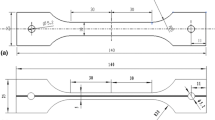Abstract
Ever increasing requirements regarding vehicle safety have led to rapid developments in various joining process. Among FSW widely used for Aluminum alloy welded structure of car body because of their remarkable performance in welding. For a better understanding of this performance, it is necessary to determine the behavior of butt weld in service conditions. In earlier phase of this study, thermo mechanical simulations and analysis are performed to understand the thermal behavior in the FSW weld zones. The developed models are correlated against published experimental results in terms of temperature profile of the weld zone. The objectives of the second part of this work is to develop and demonstrate an FE model of bumper and crash box assembly that would improve on the current modeling techniques for the mechanical response of welds in structural problems.
Similar content being viewed by others
References
F. Baratzadeh, Friction stir weld development and dynamic crash testing of bumper crash box assemblies mad from dissimilar aluminum alloys extrusions (AA6082-T6 AND AA6063-T6), Ph.D. Dissertation, Wichita State Univ. (2013).
Standard DIN EN ISO 6507 part 1 01.98, Metallic materials-Hardness test Vickers -Test methods.
F. Baratzadeh, A. B. Handyside, E. Boldsaikhan, H. M. Lankarani, B. Carlson and D. Burford, Microstructural and mechanical properties of friction stir welding joints of 6082-T6 with 6063-T6, Friction Stir Welding and Processing VI, TMS (2011).
F. Zhili and S. Simunovic, Impact modeling and characterization of spot welds, ORNL and Auto/Steel Partnership report.
K. Dudzik and A. Charchalis, Influence of friction stir welding on hardness distribution in joints of AlZn5Mg1 alloy, Solid State Phenomena, 199 (2013) 430–435.
F. Seeger, M. Feucht, T. Frank, B. Keding and A. Haufe, An investigation on spot weld modelling for crash simulation with LS-DYNA, 4th LS-DYNA Forum, Bamberg, Germany (2004).
S. A. Patil and H. M. Lankarani, Modeling and characterization of spot weld material configurations for vehicle crash analysis, Proceedings of the 10th Annual GRASP Symposium, Wichita State University, Apr. (2014) Wichita, KS, USA.
S. A. Patil, Modeling and characterization of spot weld for crash analysis, Ph.D Dissertation, Wichita State Univ. (2014).
F. Andrieux, D.-Z. Sun and H. Riedel, Development and application of a micromechanical model for the description of the growth and coalescence of spheroidal voids, IFAMST 4th International Forum on Advanced Science and Technology, Troyes, France, July 4-7 (2004).
LS-DYNA Keyword Users Manual, Version 971, Livermore Software Technology Corporation (LSTC) (2010).
A. Needleman and V. Tvergaard, On the finite element analysis of localized plastic deformation, Division of Engineering, Brown University (1982).
D.-Z. Sun, A. Hönig, W. Böhme and W. Schmitt, Application of micromechanical models to the analysis of ductile fracture under dynamic loading, National Symposium on Fracture Mechanics, 25 (1995) 343–357.
P. A. Du Bois, S. Kolling and W. Fassnacht, Material modeling with LS-DYNA for crashworthiness analysis, LSDYNA Forum, Bad Mergentheim, Germany, V2 (2002) 1–56.
B. Yingbin and W. Tomasz, A comparative study on various ductile crack formation criteria” impact and crashworthiness laboratory, Journal of Engineering Materials and Technology, 126 (3) (2004) 314–324, Doi: 10.1115/1.1755244.
G. R. Johnson and W. H. Cook, Fracture characteristics of three metals subjected to various strains, strain rates, temperatures and pressures, Engineering Fracture Mechanics, 21 (1985) 31–48.
D. S. Jeremy, A. Gilar, A. K. Jerome and R. L. John, High strain rate, high temperature constitutive and failure models for EOD impact scenarios, 2007 SEM Proceedings (2007).
J. H. Song, H. Huh, H. G. Kim and S. H. Park, Evaluation of the finite element modeling of a spot welded region for crash analysis, International Journal of Automotive Technology, 7 (3) (2006) 329–336.
National Highway Traffic Safety Administration, http://www.nhtsa.dot.gov[cited 2014].
Crash Dynamics Laboratory, Research and Development Facility, General Motors Cooperation, Detroit, MI, USA.
F. Baratzadeh, Y. Tay, H. Lankarani and S. A. Patil, An experimental and numerical investigation into the dynamic crash testing of vehicle bumper fabricated using friction stir welding and gas metal arc welding, International Journal of Crashworthiness, Paper No. IJCR. 828.
T. Hasan, H. N. Tien, S.-H. Hur and Y.-J. Kwon, Mechanical properties of graphite/aluminum metal matrix composite joints by friction stir spot welding, Journal of Mechanical Science and Technology, 28 (2) (2014) 499–504.
S. Baragetti and G. D’Urso, Aluminum 6060-T6 friction stir welded butt joints: fatigue resistance with different tools and feed rates, Journal of Mechanical Science and Technology, 28 (3) (2014) 867–877.
Author information
Authors and Affiliations
Corresponding author
Additional information
Recommended by Editor Chongdu Cho
Sachin Patil is doctoral student of Dr. Hamid Lankarani, Mechanical Engineering at Wichita State University. He has specialized in the application of explicit integration techniques for crashworthiness and impact weld failure problems. He has over 15 years of expertise in the field of numerical simulations, and have the distinction of being qualified as crash analyst with weld failure propagation. He has authored scholarly articles in the crashworthiness, optimization field, in professional as well as major trade publications and consult on the use of numerical simulations using LS-DYNA/ABAQUS.
Hamid Lankarani is a Professor of Mechanical Engineering and a Senior Fellow of the National Institute for Aviation Research, at Wichita State University. He began his professional career in 1981. Dr. Lankarani is one of the world’s leading researchers and educators in the field of impact dynamics, automotive and aircraft crashworthiness, occupant protection, and injury biomechanics.
Rights and permissions
About this article
Cite this article
Patil, S., Tay, Y.Y., Baratzadeh, F. et al. Modeling of friction-stir butt-welds and its application in automotive bumper impact performance Part 2. Impact modeling and bumper crash performance. J Mech Sci Technol 31, 3225–3232 (2017). https://doi.org/10.1007/s12206-017-0612-4
Received:
Revised:
Accepted:
Published:
Issue Date:
DOI: https://doi.org/10.1007/s12206-017-0612-4




